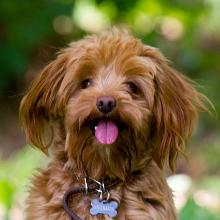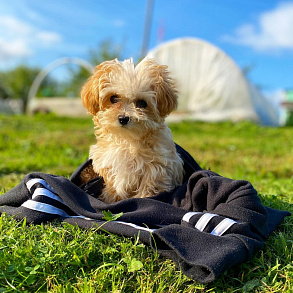Petersburg Orchid

The St. Petersburg Orchid is an author's breed of image long–haired dogs bred in St. Petersburg. Distinctive features of animals are a miniature complexion, ultra–sociability and a positive attitude to life.
- Brief information
- Highlights
- Breed characteristics
- History of the St. Petersburg orchid breed
- Petersburg Orchid breed standard
- The nature of the St. Petersburg orchid
- Education training
- Maintenance and care
- Health and diseases of St. Petersburg orchids
- How to choose a puppy
- The price of the St. Petersburg orchid
Brief information
- Breed name: Petersburg Orchid
- Country of Origin: Russia
- The time of the birth of the breed: 1997
- Weight: 2-4 kg (In low-weight orchids from 700 g to 2 kg)
- Height (height at the withers): 17-30 cm
- Lifespan: 12-15 years
Highlights
- The breed is not recognized by international cynological associations and continues to be formed exclusively by the efforts of the Russian breed club called "Petersburg Orchid".
- The main population of St. Petersburg orchids lives in Russia. Single individuals, mainly of the pet class, are exported abroad.
- The name of the breed was not invented by chance: the image dogs were brought out in the city on the Neva River on the eve of the celebration of its 300th anniversary.
- The St. Petersburg orchid is the best pet for stay–at-home people, since representatives of this family do not have to be walked.
- Unlike other decorative dogs, bitches of standard St. Petersburg orchids have no difficulties with bearing and giving birth to offspring. According to the rules of the breed club, individuals who at least once had to have a Caesarean section are no longer allowed to breed.
- Petersburg orchids are trouble-free in terms of livability and easily share territory with other dogs, cats and even rodents.
- The breed uses its voice rarely and only when necessary, so silence in the house where such a dog lives is provided.
Petersburg Orchid is a small shaggy happiness, the appearance of which causes a feeling of sincere emotion and a desire to gently squeeze its owner. The breed was bred as an image-companion, so its representatives live only in apartments, and appear more often at social events and in social networks than on walks. It is not difficult to attract attention to yourself if you have an orchid under your arm – most Russians are still not aware of the existence of such dogs. However, it would be pointless to show excessive ambition. Traveling around exhibitions and collecting champion diplomas with St. Petersburg orchids will not work due to the fact that the breed has not yet been standardized by any cynological federation.
Breed characteristics
History of the St. Petersburg orchid breed
The idea of creating the breed belongs to Nina Nasibova, the owner of the nursery "From Lake Long", specializing in breeding Russian toy. In the 90s, the breeder wanted to give the world a new kind of decorative dogs that combine external charm, but do not require complex grooming and specific care. As a result, the experiment was carried out with the participation of representatives of various toy breeds that gave offspring that were heterogeneous in terms of further breeding.
The work on the formation of the "orchid" phenotype lasted for several years. Moreover, according to Nina Nasibova herself, most of the puppies born were distributed free of charge, as they did not meet her expectations. It was possible to get the first individuals similar to today's "Petersburgers" only in 1997. At the same time, information about the breeding producers used for mating was carefully hidden. According to one version, the owner of the nursery planned to protect the breed from uncontrolled breeding by unscrupulous breeders in this way. On the other – for commercial reasons and the desire to retain the exclusive copyright.
One way or another, but already in 2007 a patent was issued in the name of Nina Nasibova, and her wards received their registration number from the Ministry of Agriculture. So far, the St. Petersburg orchid breed is in the status of developing, at the same time, most of its representatives receive full pedigrees when selling. There is another interesting nuance that restricts the breeding of cute shaggy dogs: at the request of the breeder, mainly pet and show puppies are sold outside the Leningrad Region, as well as abroad.
Video: St. Petersburg Orchid
Petersburg Orchid breed standard
Representatives of the breed are compact, stretched format dogs, distinguished by exemplary behavior in the home walls, but adoring to be active during walking, if such happens. There are standard (2-4 kg) and low-weight "orchids", whose body weight ranges from 700 g to 2 kg. Baby dogs look incredibly cute and are very popular, but due to anatomical features that complicate reproductive processes, they are never sold as breed pets.
The height of an adult St. Petersburg orchid is up to 30 cm at the withers, so all individuals who have crossed this barrier are considered a plembrac. The minimum height limit for a dog is 17 cm . Sexual dimorphism in the breed is very weakly expressed, which greatly facilitates the choice of a pet if only the exterior characteristics of the dog are important for the potential owner.
Head
The rounded skull of the St. Petersburg orchid fits well into the shape of a square. The light dry head of the dog is distinguished by the straight outlines of the contours and the average size. Mandatory breed condition: the length of the muzzle must be at least ⅓ the length of the head.
The muzzles of St. Petersburg orchids may be slightly pointed in the nose area, but the classic narrowed shape is atypical for them. The stop is distinct, without excessive sharpness, the area under the eyes is well filled. The muzzle line is always parallel to the frontal line.
Lips and teeth
Lips are dry rather than fleshy, closely adjacent to the teeth. The teeth are smallish, forming a scissor bite in the bow. It is always preferable to have a complete dental formula.
Nose
The lobe is very small, matching the color of the main color or a rich black tone.
Eyes
The eyes of the St. Petersburg orchid have a straight and wide landing with a very dark color of the iris. The incision of the eyelids is oval-almond-shaped.
Ears
Medium-sized ears have rounded tips and effectively hang down on the cartilage. The ear cloth is evenly covered with wool.
Neck
A slight bend is characteristic of a long, emphatically dry neck.
Housing
The bodies of St. Petersburg orchids are elongated, having a stretch interval of 106-108. The moderately convex withers is continued by a straight line of the back, forming a convex zone only in the lumbar region. A wide croup is characterized by a barely noticeable sloping with an angle of inclination from 15 to 30 °. The chest is distinguished by a normal depth and a good width for a decorative dog. The stomach is strongly tightened.
Tail
Cupping of the tail is allowed. If the cupping procedure was not performed, the tail takes the form of a saber, less often – a ring.
Limbs
The length of the legs of the St. Petersburg orchid is ½ of its height (at the withers). Parallelism and straightness of the forelimbs are mandatory breed characteristics. Shoulder angles have a degree in the range from 90 to 110, elbows tightly touch the sides of the dog, the position of the pasterns is vertical. The hind legs of the "orchids" are kept parallel, showing well-defined angles of articular joints and vertical metatarsals. Paws are small, in a lump. The movements are fast, with parallel removal of limbs and a good push.
Color
Formally, the St. Petersburg orchid can have wool of any color except white. At the same time, the palette of permitted colors is replenished from time to time with some new "instance". The most common breed suits for today:
- tiger (in gradation from red to gray);
- all variants of red;
- black and tan with tan from light gray to brick red;
- fawn;
- black;
- cognac;
- cream rose;
- chocolate-tan;
- chocolate;
- zonal in different colors;
- purple;
- blue;
- silver.
Small white marks on the chest, paws and muzzle are considered an acceptable feature. The presence of masks on the muzzles and so-called straps on the backs of animals is regarded as a normal exterior phenomenon.
Wool
The outer hair is quite long, soft and much larger than the undercoat. In some individuals, the coat has a slightly wavy structure. For all representatives of the breed, a special type of haircut has been developed, which is called orchid. The peculiarity of grooming an animal is that the hair on its back and neck is removed according to the same scheme as that of the cocker spaniel . Mustache, beard, bangs and ears remain covered with a layer of soft awn. Also, the wool is cut off from the knuckles, and the hair on the lower part of the body and sides is decorated in a fluffy skirt.
Important: not so long ago, a short-haired variety of the breed, called the Neva orchid, appeared. Neva dogs look a little less glamorous than their shaggy relatives, but they do not need a haircut.
The nature of the St. Petersburg orchid
When creating the breed, attention was focused on the formation of those qualities in its representatives that would allow them to become ideal companions for the inhabitants of the metropolis. As a result, St. Petersburg orchids turned out to be comfortable in all respects and maximally urbanized pets. These glamorous kids are never sad, radiating round-the-clock positivity, and they are equally willing to frolic on a walk and sit on the couch in front of the TV for the company of the owner.
Despite the almost dwarfed dimensions, St. Petersburg orchids are not cowardly at all and have a sustained character. They are not characterized by nervous tantrums and barking "just because it's boring", while they get along wonderfully with all representatives of the domestic fauna. Accordingly, if you need a dog that will find a common language with your independent cat, it's worth looking at the "orchid".
Non–selectivity in the expression of feelings of affection is a trait that representatives of the breed developed purposefully. The St. Petersburg Orchid is that rare type of dog that equally loves, respects and listens to all family members. Moreover, these stylish kids are very trusting, so they are ready to jump on the handles to any person entering the house. As for the watchdog skills, the orchids are not outsiders in this field either. Of course, such a tiny "tail" is not able to scare an attacker, but it will be perfectly able to spread the news that someone else is trying to get into the apartment.
Another interesting behavioral trait of the breed is the ability to adapt to the pace of the owner's life. Breeders assure whether the dog will grow up to be a sofa pet or become a clockwork dog – depends only on the person. The "orchids" themselves quite normally perceive both a passive lifestyle and its opposite variant.
Education training
Petersburg orchids are celebrities of the dog world, who more often sit under the arms of their owners at social events than run along the paths of parks. For this reason, classical training is not as important for the breed as good upbringing. Fluffy "Petersburgers" are smart, curious and willing to learn everything new, but only on condition that the owner did not miss the time and properly organized the learning process. The most common mistake in the upbringing of the St. Petersburg orchid is connivance and the hope that such a small pet is simply not able to spoil the life of the owner. Believe me, it's still in a state. From the first days of life, take the animal seriously, but without excessive rigidity: remember, the breed was bred for love, not for drill.
Usually St. Petersburg orchids are given to new owners who have grown up and mastered the basic behavioral rules. For example, representatives of this breed very quickly understand how to properly go to any toilet, starting with a tray and ending with a diaper, and do it earlier than other puppies. Also, do not be lazy to teach your pet to walk on a harness: of course, you can carry an animal on the street and on your hands, but this is not very convenient, and it is always useful to run around the "orchid" living in the apartment. Mandatory commands that must be taught to a decorative dog are "To me!" and "You can't!". Thanks to the first, it is convenient to control the behavior of the pet, and the second will help in stopping undesirable actions, especially when it comes to picking up conditionally edible items on the street, characteristic of all four-legged pets.
Don't let the puppy argue with you, namely: growl, drag toys out of your hands with your teeth, demonstrate disagreement with the requirements by biting your fingers. Of course, the tiny dog will not cause physical damage to his health, but gradually he will form an extremely unpleasant behavior model. For the same reason, a dog should know its place in the house. Even if you adore when the "orchid" is peacefully dozing next to you on the couch, try to arrange a separate corner with a basket for her, not forgetting to work out the command "Place!" and periodically use it when the pet invades your personal space too intrusively.
You won't have to compete for the leader status with the St. Petersburg orchids, but the animal still needs to show who is in charge in the house. The easiest way to do this is to feed the pet after people have had lunch. At the same time, no delicious compensations are offered to the four-legged prankster during the feast. This approach will help the fluffy quickly and correctly fit into the hierarchical system of the family, since the psyche of St. Petersburg orchids is the same as that of most dogs.
Maintenance and care
In the breeders' interviews about the breed, the emphasis is always on the unpretentiousness of its representatives in terms of care. But do not take such information literally – it will not work to ignore the dog's image at all. Like any decorative pet, the St. Petersburg orchid is extremely necessary and hygienic procedures with professional cosmetic products, and light grooming.
The classic care scheme is washing the wool with shampoo that prevents the formation of tangles, followed by the use of special conditioning compounds. After such means, the awn becomes smoother and does not get tangled, and a dog washed in this way can not be combed for a whole week. A specific breed haircut that allows you to fully reveal the exterior potential of the "orchid" only looks complicated. In fact, it is easy to do it yourself, without resorting to the services of a groomer.
A nice bonus for all fans of the breed is the absence of seasonal molting among its representatives. So if you prefer cleanliness, but do not like to collect bunches of wool from carpets, with St. Petersburg orchids you are on your way. Of course, during the life of the animal's hair periodically dies, but if the owner does not neglect combing the pet, there will be no scraps lying around the apartment – they will all remain on the comb. It will not be possible to avoid cleaning the ears and eyes of St. Petersburg orchids, but since this process is simple, it will not take much time. It is enough just to buy a hygienic lotion softening the sulfur in the ear funnel, and for the eyes to use a clean cloth moistened with a decoction of chamomile flowers.
Feeding
Petersburg orchids are not indifferent to standard dog treats, but they do not suffer from gluttony. The tendency to obesity in representatives of the breed is also not revealed, so you will not have to weigh the daily feed rate on the scales. According to N. Nasibova herself, "orchids" are able to live their whole life on "drying", which will not harm their health. The only and mandatory condition is that the food must be of high quality and at least super-premium class.
At the same time, the creator of the breed keeps her producers on the so-called species nutrition, which implies a complete rejection of the heat treatment of products. According to the breeder, this approach has a positive effect on the health of the teeth of animals – "Petersburgers" who consume natural food do not suffer from tartar, and their breath is always fresh.
So, what do dogs eat in Nina Nasibova's kennel? First of all, raw lean meat and offal. Once a week, adult St. Petersburg orchids are offered fish fillets – hake, pollock, cod or sea bass, as well as one raw quail egg in a shell. At the same time, cereals are completely excluded from the diet. Vegetables, fruits and young greens fall into the animal's bowl only in raw and finely chopped form. Usually, over time, the dog has its own favorite types of plant foods. For example, some individuals respect fruits more, others are delighted with tomatoes and carrots. It is not recommended to try to change the taste preferences of "orchids" – leave the freedom of choice to the pet.
Important: very carefully introduce chicken and its waste into the diet. St. Petersburg orchids that have been eating this type of meat for a long time may begin to leak their eyes and dandruff appears.
Adults are fed twice a day. Usually the norm of food is determined by eye, depending on the motor activity of the pet. The creator of the breed recommends putting a bowl with lunch in front of the puppy and taking no more than 10-20 minutes for the feeding process. If the dog has finished eating earlier, the next time the portion can be slightly increased. If, on the contrary, you haven't finished eating, then put less food in a bowl.
Cartilage, flat bones and chicken heads, as well as fermented milk products will help to cover the growing dog's need for collagen and calcium. As for pharmacy dietary supplements, the appropriateness of their use is determined by the owner. Nina Nasibova recommends choosing natural food additives, focusing on the fact that all dogs in her kennel do without synthesized vitamins and give excellent offspring.
Health and diseases of St. Petersburg orchids
Since the breed continues to form, and its creator does not stop breeding experiments, it is extremely difficult to identify the pattern of development of genetic diseases in animals. Reassuring is the fact that the breeder conducts a strict cull of puppies and producers, mating only between completely healthy individuals, which allows you to get healthy offspring. Separately, it should be noted the low-weight "orchids", which, like most dwarf breeds, have an extremely fragile physique and cannot produce offspring on their own. When taking such a dog into the house, get ready to create a safe environment for it – mini-dogs get injured very easily.
How to choose a puppy
- Carefully choose a breeder and a nursery. Please note that permits for breeding St. Petersburg orchids are issued only by Nina Nasibova's club.
- It is not recommended to take puppies of small individuals (up to 2 kg) into a family with children, since an overly miniature animal is more easily injured due to careless handling.
- Official kennels issue a whole package of documents when selling their wards, which should also include a club puppy card, personally certified by N. Nasibova.
- All purebred "orchids" should have a tattoo stamp located in the groin area. The number of the brand and the puppy metric of the animal must match.
- Find out how many puppies were in the litter initially. It's great if there were no more than 3-4 kids. In too large litters (St. Petersburg orchids bring up to 7 puppies), animals often lack mother's milk, which negatively affects their immunity.
- The cost of a puppy largely depends on its color. The most popular and expensive suits of the breed are chocolate, tiger, cognac, bright red with black.
- If you want an animal from N. Nasibova's personal kennel, find the Vkontakte page of the breed creator to arrange a meeting and get information about the breed from a person who knows everything about it. There you can also see a list of nurseries that have the official permission of the club to sell puppies of the St. Petersburg orchid.
The price of the St. Petersburg orchid
A pet-class dog with an official package of documents from the breed club will cost $400. St. Petersburg orchids that fit into the super-mini format are more expensive. As for the breed individuals, it is quite difficult to get them, unless you are a breeder with experience and exhibition awards. The author of the breed treats the breeding of animals very tenderly, preferring to personally control all the mating and selection of breeding pairs, therefore, in the vast majority of cases, potential producers "settle" with breeders living in the Leningrad region.


